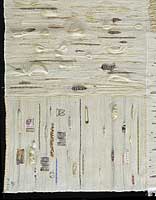
Wall hanging
Adaladalana (Craziness)
Woven by Zoarinivo Razakaratrimo
Merina peoples, Madagascar
2000
Sisal, raw fibers, spices, bean pods and found objects
National Museum of African Art,
Smithsonian Institution,
museum purchase, 2001-13-45
|

Wall hanging (detail)
Adaladalana (Craziness)
Woven by Zoarinivo Razakaratrimo
Merina peoples, Madagascar
2000
Sisal, raw fibers, spices, bean pods and found objects
National Museum of African Art,
Smithsonian Institution,
museum purchase, 2001-13-45
|
